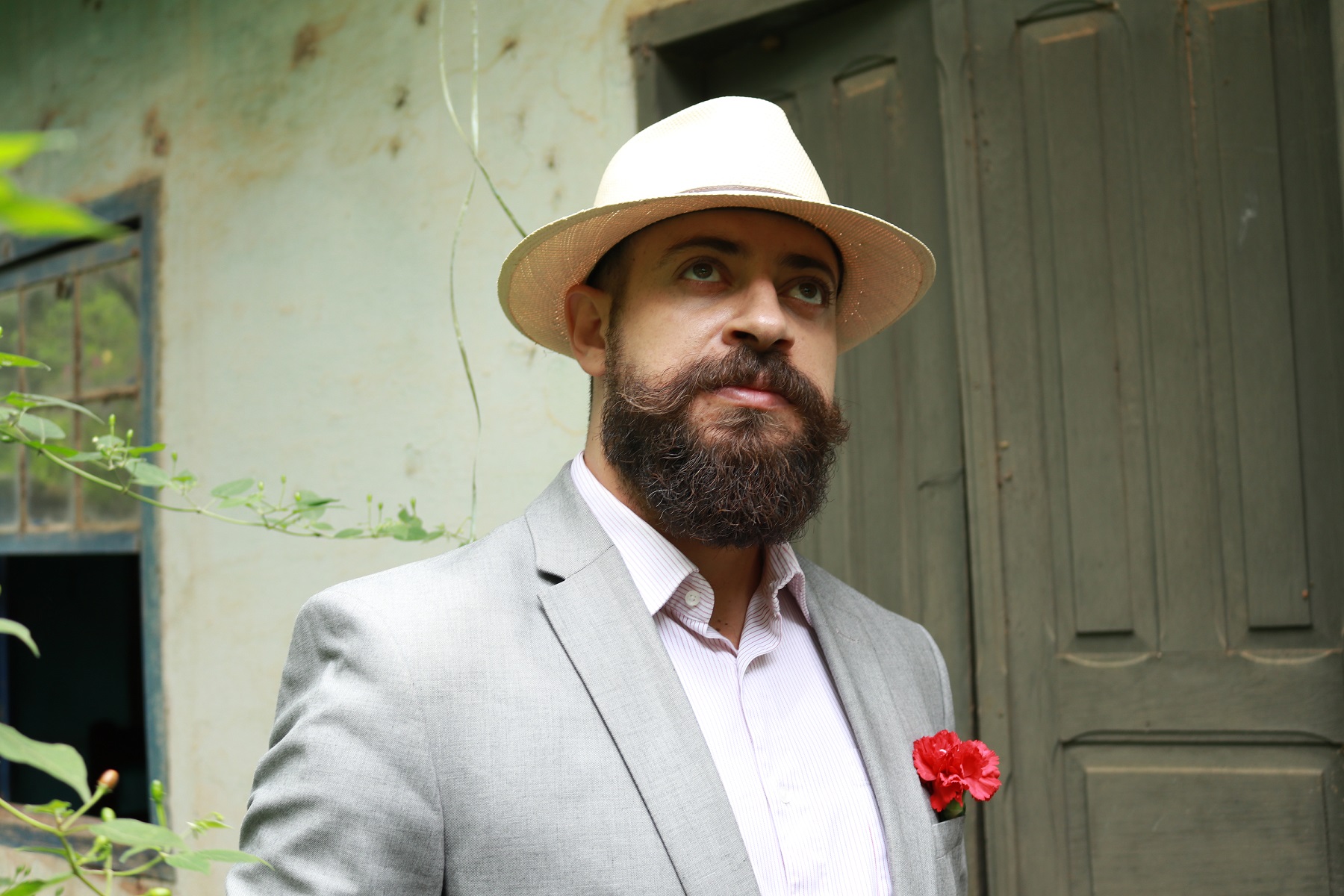
Award winning wizard of the mandolin, composer and authority in the art of Brazilian music
Danilo Brito, multi-instrumentalist and composer, presents a work of his own, building a repertoire that spans more than 150 years, united by the verve and structure of the original, and inspired to blossom anew in the 21st century. Add to that his knowledge of the greatest composers and compositions of pillars of Brazilian instrumental music to which he lends his unique interpretation. A completely self-taught musician, he developed his own technique and style beyond time and place.
Critic Joshua Peacock, in his review on Brito's performance at the Savannah Festival, called him a "rock star," referring to the impact of his show at the festival, which presented great international music; and thus summed up, "Brito's presentation was a clear display of his musical virtuosity, and any compliment in words that I can concede will fall short."
His album “Da Natureza das Coisas”, that includes his compositions, performed with his ensemble was chosen “Top of the World” by Songlines Magazine in 2020.
While live concert work has been made impossible by virtue of the circunstamces, Brito has created another way to communicate his art. His new YouTube channel is filled with presentations, with subtitles in several languages, including Portuguese and English, that introduce viewers to much of the foundational knowledge that he has gained in his journey. His channel has over 5 milion views and more than 70K subscribers. As he told the audience in 2004 when winning Brazil’s most prestigious musical award, he continues “to take care of our music.”
His album “Esquina de São Paulo” in duo with classical guitarrist João Luiz, released in 2021 by Soho Music in the USA and co-produced by multi Grammy Award winner Kabir Sehgal, was very complemented by critic, “(...) not quit jazz, and not quite classical, yet containing elements of both. Brito’s mandolin dominates in this one, displaying a technique equally as impressive as that of the legendary Gypsy guitarist Django Reinhardt. (...) I can’t recall having heard a mandolin player in the past 30 years as thoroughly enjoyable to listen to as he is.”
His art is recognized national and internationally, not only as a major representative of contemporary Brazilian music but also as an unique interpreter, capable to capture the hearts of listeners worldwide.
His school is the Choro music of Brazil, a child of the same cultural parents as jazz and blues in the U.S. - European forms melded with African ideas to produce a family of fresh, new forms throughout the New World - it is marked by virtuosity syncopation, counterpoints and improvisation besides an intense expression of feelings, from cheerful to melancholic, features clearly present in Brito’s music.
Brito has played worldwide to full houses at famous jazz clubs, art centers, national festivals and national radio such as the NPR Music Tiny Desk Concert, the Savannah Music Festival, The Red Sea Jazz Festival, the Spoleto Festival, The Ellnora Festival at Krannert Center, Jazz at Lincoln Center in New York, The Mondavi Center for Arts in California, The Kennedy Center in Washington DC, among others.
History
Danilo Ezequiel Brito de Macedo was born on March 29th, 1985 in São Paulo, Brazil, the youngest of five children. Both of his parents are from northeastern Brasil: his father, Democrito Brito, from the countryside in the state of Paraíba, and his mother, Noemia, from the coast in the state of Bahia. 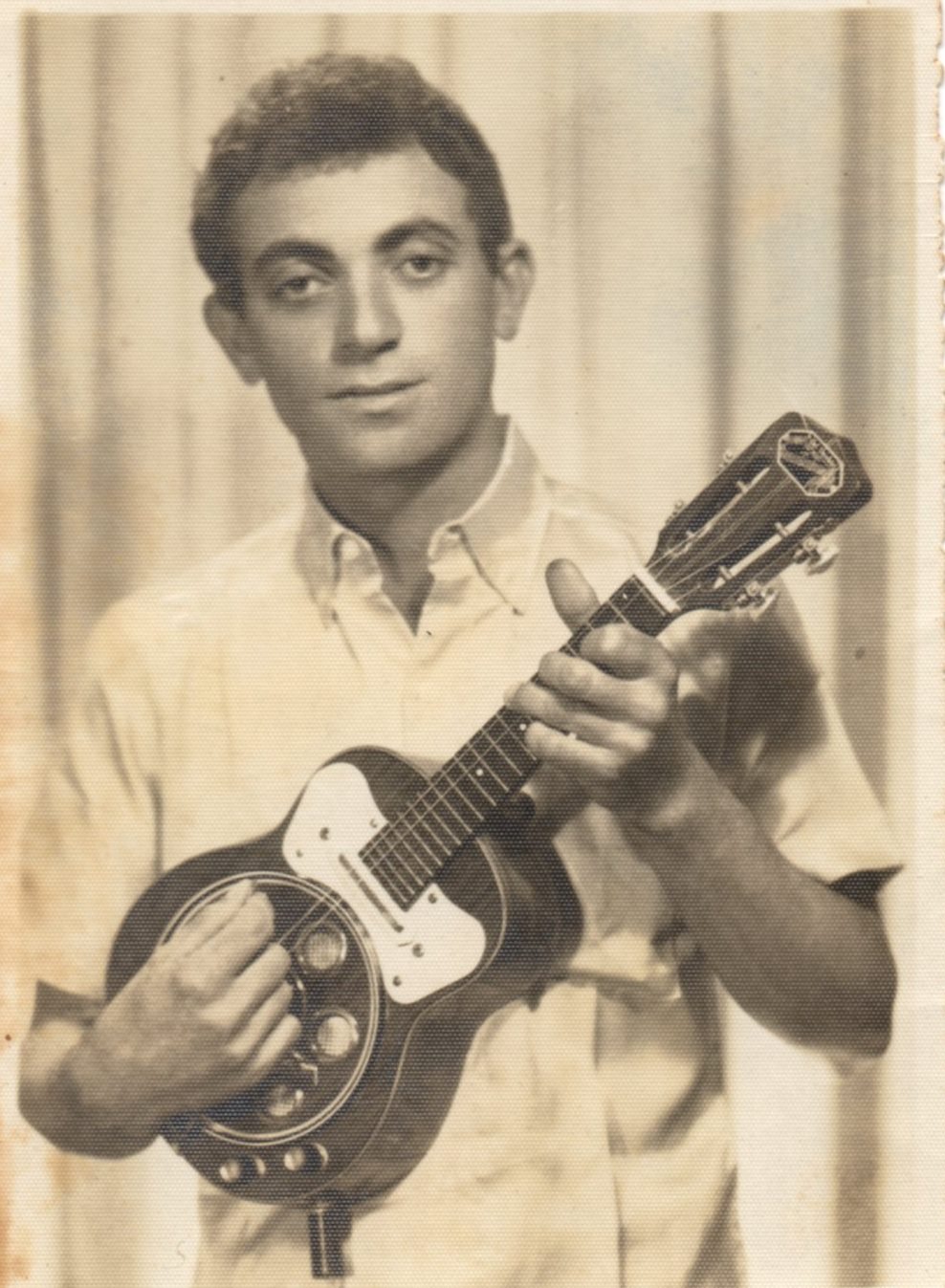
Sr. Democrito: an inspiration
Democrito was given a cavaquinho1 when he was 11, a gift from his grandmother. She traded two chickens for the instrument with a traveler who had passed by their farm. At the farm, there was no radio or even recordings so that he could learn, at least by ear, the tuning of the instrument. This did not prevent the boy from playing. The young Democrito created a tuning for his cavaquinho and, in this way, he could play many frevos and choros. In his youth, he cheered many village balls with his music. He often accompanied an accordion player named “Paizinho Amador” (died in 1966).
When Democrito arrived in São Paulo in 1957 at the age of 22, he performed in public a few times including an occasion with Paizinho Amador (read more) who lived in São Paulo for a while. Democrito also won second place as best instrumental player in a radio contest called “Hora do Pato,” but he always kept music as a hobby.
1. A cavaquinho is a typical Brazilian instrument that looks like an ukulele, but has a completely different sound and tuning. It is used for solo or accompaniment in Brazilian music.
First notes
At the age of three Danilo took his father’s mandolin from a chair and played the separate strings clearly. At age five, he surprised everyone in the room by playing a sequence from the song Delicado, by Waldir Azevedo, something that he had learned on his own. Danilo recalls from his very first years that he could identify and correct wrong notes or notes different from the original recordings when listening to someone performing. He started playing both mandolin and cavaquinho equally, mainly Jacob do Bandolim2 and Waldir Azevedo3 compositions.
He did not have lessons, not even from his father, and developed a unique technique of his own by listening to vinyl recordings and practicing with an old instrument of his father’s, a difficult one for such small fingers to produce sound. Danilo has kept much of this technique, which contributes to the natural manner of his musical expression.
Throughout his youth, Danilo’s father organized simple Rodas de Choro1 with amateur musicians from the neighborhood. Although very simple, they provided Danilo a solid foundation for learning and a great source of joy.
1. A Roda de Choro is a informal gathering of musicians to play songs of different Brazilian composers, similar to a jam session.
2. Jacob do Bandolim (1918-1969) is a mandolin soloist, group leader and a major Choro composer. He is considered by many musicians to be the precursor of the authentic Brazilian mandolin school.
3. Waldir Azevedo (1923-1980) is a cavaquinho soloist, group leader and composer, who recorded many albums and performed around the world. He is the composer of one of the most well-known choros, Brasileirinho.
Life on the farm
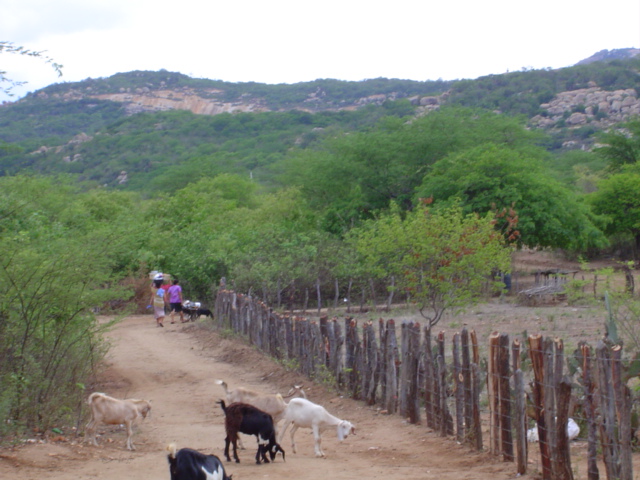
At the age of eleven, Danilo lived on the family farm in Paraíba, where he had the opportunity to learn tunes from Antônio Messias, and to improve his technique on cavaquinho and mandolin (actually, a cavaquinho tuned as a mandolin). He acquired new Brazilian repertoire, especially Choro, but also frevos and baiões1.
From living in the northeast of Brasil, Danilo absorbed accents that can be heard in his music, interpretation and composition. The countryside environment of Cariri, in Paraíba, had a strong impact on his childhood imagination. There was no electricity and people spent their time telling stories by candle or moonlight. There were sounds of accordions all around, and the cheerful and melancholic music would tell a lot more beyond the simple rural life.
Danilo did his first live appearance from a radio station, at Rádio de Sumé. He performed with Antônio Messias accompanying him on guitar and among the music he played was Diabinho Maluco, by Jacob do Bandolim, one of his favorites.
1. Baião and Frevo are two music genres typical of the northeast of Brazil. Similar to Choro music it can very cheerful and yet still have something of melancholic.

Rodas de Choro in São Paulo
Returning to São Paulo, Danilo dedicated his studies equally to cavaquinho and mandolin, and started to attend the famous Rodas de Choro of the traditional music shops Contemporânea (still in business) and Del Vecchio in downtown São Paulo. Many of the best Brazilian instrumentalists played there in a very informal way. In these Rodas Danilo met and played with great Choro musicians: Dino 7 Cordas, César Faria, Carlos Poyares, João Macambira, Dorival Malavasi, Antônio Rago and many others.
These gatherings are a kind of academy for a musician, requiring a lot of knowledge, memory, and repertoire. Due to the musical complexity of Choro, the musicians´ virtuosity, and the complicated melodies, the Rodas de Choro develops the ability of the musician to play in a group, to respect the role of each instrument, to understand harmony, to follow time and rhythm, to learn timing for improvisation.
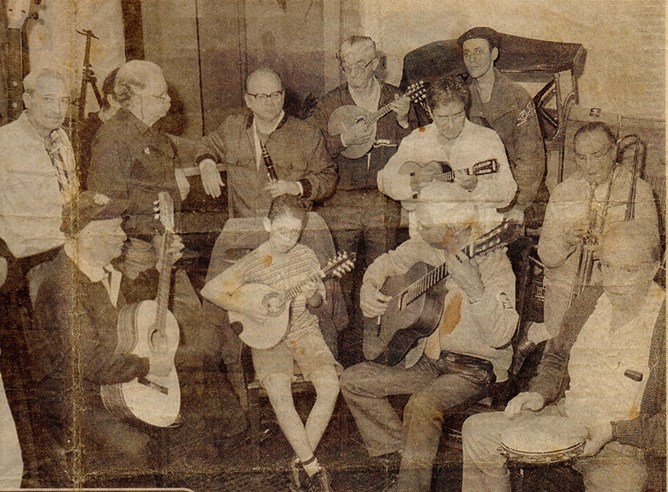
Roda de Choro at Del Vecchio
Danilo refers to this time with love: “These Rodas used to start every Saturday morning. I'd begin at Del Vecchio shop, and then right after, I would walk just a few blocks to Contemporânea for another Roda. From there, I would go straight to Manoel Andrade’s luthiery for another Roda. Rain, winter, nor illness could hold me back. I attended these Rodas every single Saturday for more than ten years.
“I used to anxiously wait the whole week for those Saturdays, when I would have the opportunity to meet friends and play the entire day the choros I had listened to during the week from the old vinyls. At that time, there weren’t many young people at the Rodas and many of my friends were gray-haired, but it did not occur to me. Today, the age difference occurs to me simply because I miss a lot of them and I am grateful that I still have the company of others, my companions from those happy years.”
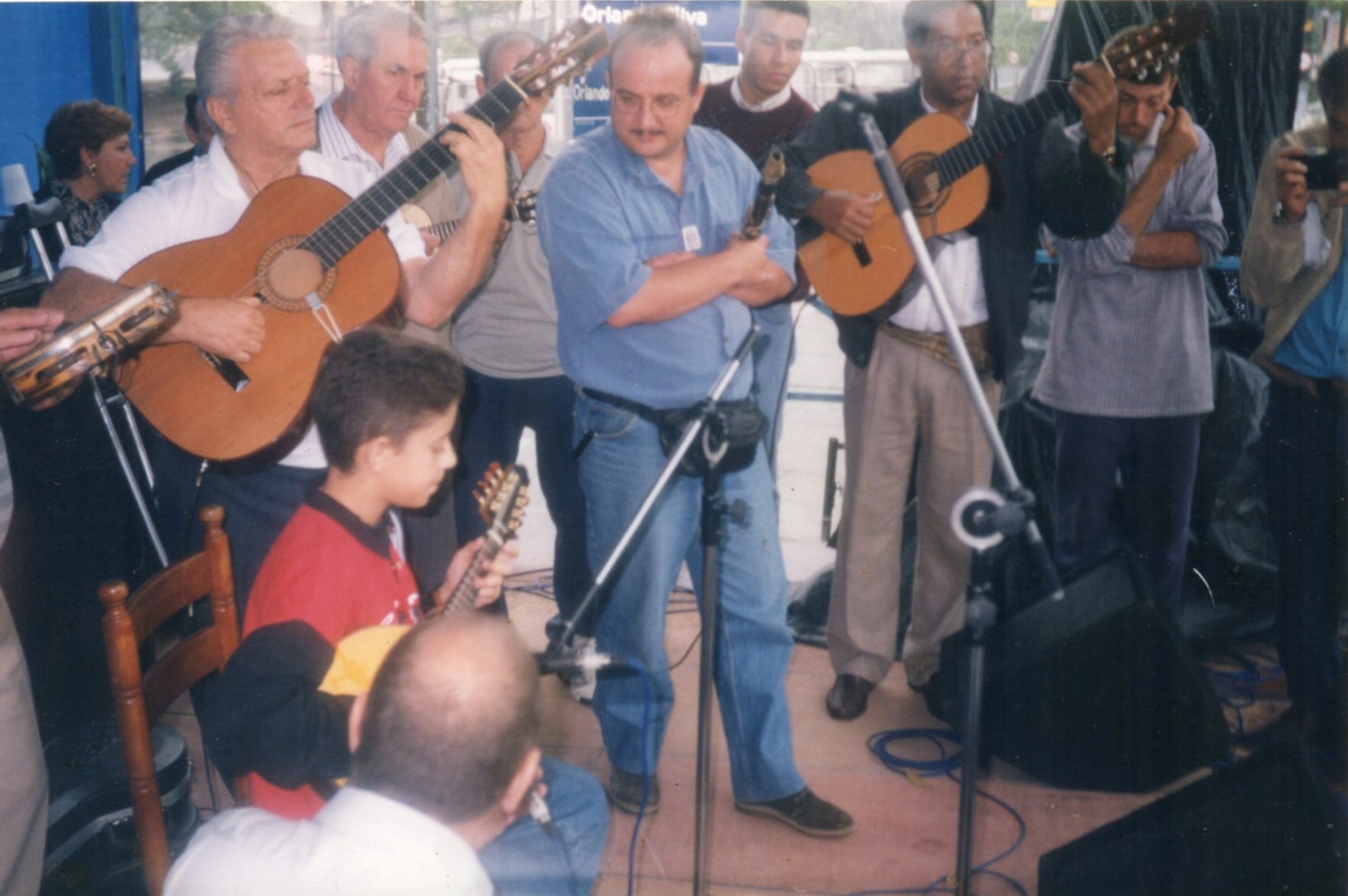
Orlando Silva Square with Baloi, Toninho Gallani, Stanley, João Macacão, Milton Mori
First public performances
Danilo was still playing his father’s old mandolin when he got his first instrument made by a luthier. From this point on, Danilo adopted the mandolin as his main instrument, always finding time to dedicate to it. Nevertheless, he did not give up playing the cavaquinho and also started playing tenor guitar. Slender and very young, Danilo was impressive not only because of his youth but also because of the superb technique with which he executed waltzes, choros, polkas, sambas and frevos. His astonishing interpretation was such that he was often likened to Jacob do Bandolim. The luthier and guitar player Manoel Andrade (in memoriam) in an interview given to the newspaper Jornal da Tarde said: “I cannot say anything about it. But that he is abnormal. I’ve seen this kid learn in 10 minutes what I needed 10 years of study to get.”
He began to receive invitations from celebrities, artists and members of the press to perform and to give interviews and demonstrations of his talent. The first time he played a solo performance was at UNIBAN (Bandeirantes University), along with the group Bachorando, whose leader was his friend, the guitarist Nelson Galleano, affectionately referred to as Baloi.
First Album: Moleque Atrevido
Producer Téo Azevedo met Danilo Brito at one of the Rodas de Choro and was so impressed that he immediately wanted to record his music. When he asked Danilo if he would like to record an album, the answer was “yes,” but Téo Azevedo responded: “Now I’m going to have to talk to your father, you are very young.” Then, at 13, with full support from his family and friends, his first CD, Moleque Atrevido, was recorded comprised of songs by Chiquinha Gonzaga, Jacob do Bandolim, Waldir Azevedo and others.

Moleque Atrevido group, with João Macacão, Milton Mori, Joãozinho do Cavaco, Marco Bertaglia, Tigrão, Baloi, Marcelo Gallani
Danilo Brito and great artists
At 14, Danilo’s taste in music was different from the teenagers of his age. Besides the choros, waltzes, and other instrumental rhythms that he liked since childhood, he began to deepen his knowledge of Brazilian singers, especially those from the 1920’s to 1940’s, such as Francisco Alves, Carlos Galhardo, Orlando Silva, Nelson Gonçalves, Elizeth Cardoso, and Dalva de Oliveira. He spent many hours listening to their recordings. He participated in the many balls of “Caravana da Saudade”, organized by the broadcaster José Carlos Gomes, in which he played with famous radio singers such as Wilson Roberto, Noite Ilustrada, and Roberto Luna. Invited by the legendary flutist Altamiro Carrilho, he performed for the first time at Teatro Municipal de São Paulo (São Paulo City Hall). In this performance, Danilo played the choro by Severino Araújo, Espinha de Bacalhau, and got a standing ovation from the audience. At age 16, he shared the stage with another legendary flute player, Carlos Poyares, and later accompanied singers such as Cauby Peixoto and Andrea Bocelli. At about this time, Danilo formed the first Choro group with instrumentalists of his age: Paulinho on 7-string guitar; Gian Correia, known as Pingo, as cavaquinho soloist (now a great guitar player); Felipe Galeano providing cavaquinho accompaniment; and Rafael Toledo on pandeiro.
Even at this young age, Danilo was already well respected and loved. Many documentaries were made about his career, his technique and musicality, with testimonies of musicians and critics, in monographs, special reports on radio, TV and magazines. Although shy, when interviewed about Brazilian music Danilo was always eloquent. His statements about musical culture were astonishingly mature, from insightful critiques of musical trends to his declarations about what he thought to be true values.

Jornal da Tarde newspaper
Best Instrumentalist Award
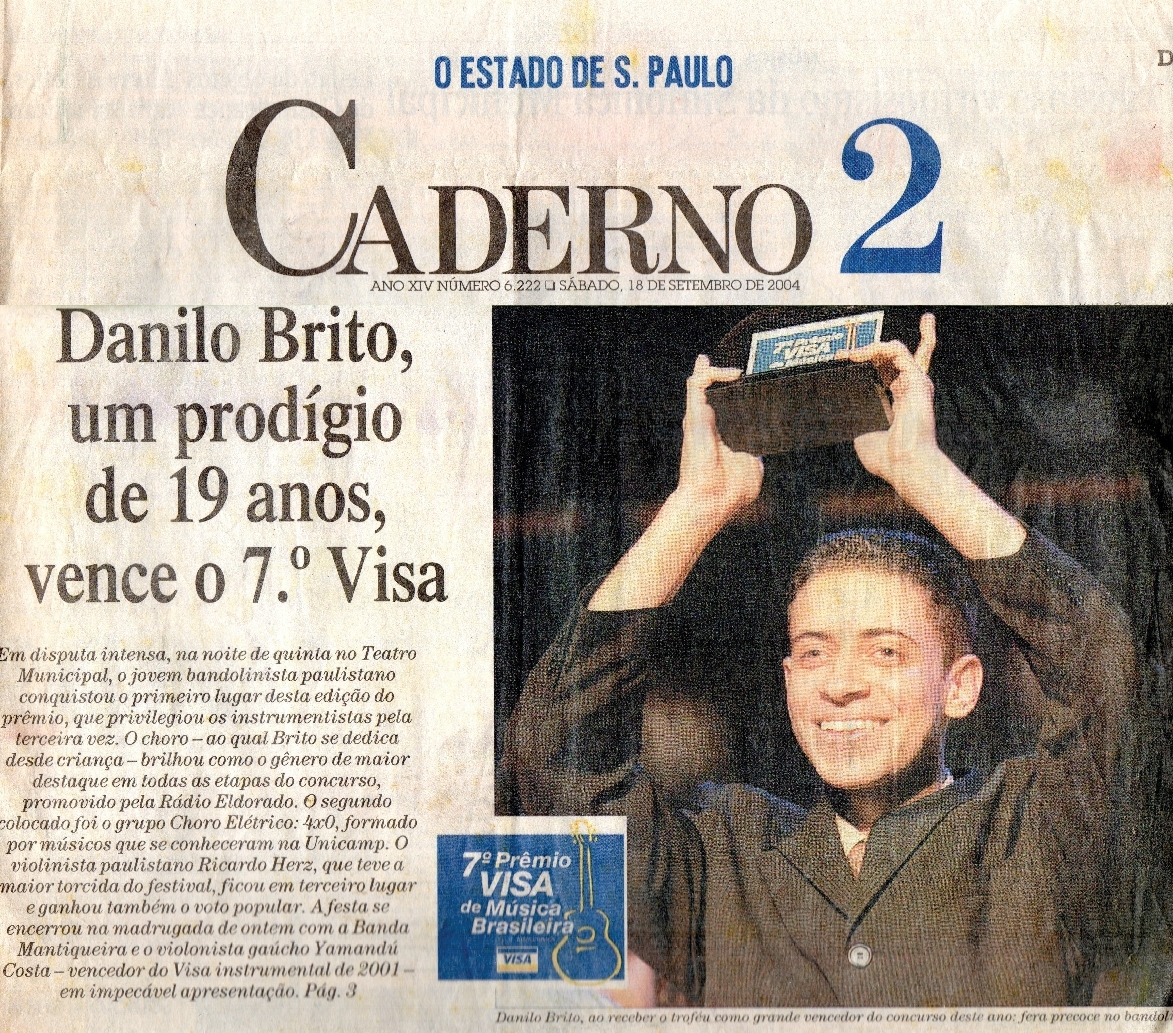
In 2004 Danilo entered and won the 7th annual VISA Awards for best instrumentalist, one of the most important awards in Brazil – beating out 514 well-trained and skillful competitors. The judges were musicians, conductors, and knowledgeable specialists in Brazilian and World Music. Friends and fans were in the audience cheering him on when he won first place. Danilo was the youngest musician to ever win first place in this important award, which has recognized many other great artists. The contest had many moments of emotion. Danilo passed out twice and at the grand finale, a problem in the sound system caused him to have to perform a second time the solo piece, Choro da Saudade, an intense composition by Agustín Barrios.
His VISA Award prize included the opportunity to record a CD with the Eldorado Recording Company. This second CD, entitled Perambulando, came out in 2005. Besides many traditional choro pieces, the CD contained some of his own compositions including the blistering Sussuarana. His tenor guitar work is featured on Um Choro na Madrugada and he has been highly praised for his interpretation of Confidências, by the great choro pioneer Ernesto Nazareth. He was joined on several pieces by legendary musicians such as Altamiro Carrilho on flute, Toninho Ferragutti on accordion, and Nailor Proveta on clarinet.
Performances
Among these years there were many performances and musical partnerships, with excellent musicians of the old and the new guard. See photos
Career abroad
Danilo is invited to play and teach his music in many festivals and conferences around the world. His first appearance was a crowded concert at the Volvo Ocean Race in Spain in 2005.

In Spain, with Zé Barbeiro and Tigrão

With Mike Marshall and David Grisman
Asked if Brazilian music is well received and understood outside Brazil he says, “I have the opportunity to play this music for unacquainted audiences and world-renowned artists. Everybody receives it with great enthusiasm. They research and look forward to learn details about the style. And I am talking about the very authentic Brazilian style. Of course it is a pleasure to see this reception to our true music, that has so much to offer.”
Recently, Danilo was considered a “phenomenon of the mandolin” by the famous North American mandolinist, David Grisman, at the Mandolin Symposium in Santa Cruz, California. Grisman also said, “Do yourself a favor and listen to Choro.”
Danilo says, “In all these years, I’ve never found a style that offered to the interpreter so many resources and with such an universal language. This music that is pure reaches more directly any audience, contrary to what one might imagine.”
Dedication to Brazilian music
Danilo Brito has dedicated his life exclusively to music since he was three.
Every Saturday for two years, Danilo organized an open instrumental jam with his own resources in a book store at Benedito Calixto Square in São Paulo. Many great instrumentalists took part and it was attended by thousands of people.
.jpg)
First Roda de Choro organized by Danilo at Virada Cultural
When he won the Visa Award as best instrumentalist, at only nineteen years old, his statement to the presenter Chico Pinheiro, the audience, journalists and photographers, was simply, “I promise to take good care of our Brazilian music.” Danilo has kept his promise, something that he has been doing since he was a child.
In January of 2015, Danilo was invited by São Paulo City Mayor for a meeting, together with the City Secretaries of Culture and of Communication. Danilo talked with them about the challenges he had in the beginning of his career, his experience as a musician in Brazil and abroad, and proposed the creation of a public space in São Paulo fully dedicated to Choro, with performances and Rodas de Choro, and a music school of Choro language with classes by masters of the genre along with "rodas de choro" and concerts of international standards. That same day, the mayor commited to promote a Choro Club.
To dedicate himself to spread the music he loves, authentic and sophisticated Brazilian instrumental music, to research its composers and interpreters of all times, to do intense group work and, above all, to put virtuosity in the service of feeling.
Danilo Brito album
In 2013, Danilo put his efforts towards gathering a group dedicated to Brazilian music, with members who shared his passion and his desire to make mature and complex works. In early 2014, they recorded their first album, Danilo Brito, which was dedicated to Danilo’s original compositions. It had a fantastic premiere at Spoleto Festival USA, in Charleston, South Carolina, USA. The album has received many enthusiastic reviews nationally and abroad.
Jon Santiago of Charleston City Paper said, “To say that Brito is a musical prodigy is almost to diminish his personal contributions to the music he loves.” “Stunning.” Cultural editor of R7 described the album as “conceptual, sophisticated and concise”.

Danilo Brito album premiere at Spoleto Festival
50 Anos de Música album
Orpheu Music produced his fourth album, an homage to the great 7-String guitar player Luizinho 7 Cordas, a symbol of tradition and good taste in his instrument and Brazilian music. The album has choros and waltzes in an interpretation full of feeling and subtlety.
Sem Restriçoes album
In 2008, Orpheu Music produced his third album, Sem Restrições. It includes different arrangements of Danilo’s music. There are recordings with the quintet Luizinho 7 Cordas, Milton Mori, Alexandre Ribeiro, Rafael Toledo and Léo Rodrigues. In a different style, Danilo performs arrangements by the maestro Laércio de Freitas with the string quartet Ensemble São Paulo. The album also included guests such as Dominguinhos (accordion), Alessandro Penezzi (guitar solo) and Rodrigo y Castro (flute).
.jpg)
Sem Restrições premiere
